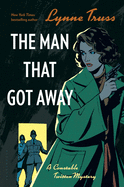
Anyone intimidated by Lynne Truss's Eats, Shoots and Leaves: The Zero Tolerance Approach to Punctuation can turn to her mystery novels to enjoy word-perfect sentences minus the reproach. Along with Cat Out of Hell, there's Truss's Constable Twitten series, the second title of which is the witty and unremittingly clever The Man That Got Away.
It's July 1957 in Brighton, England, and there's a dead body on the seafront: someone has slit the throat of Peter Dupont, a 17-year-old clerk in the Sewerage and Waterworks department. On the case is young Constable Peregrine Twitten, who, as it happens, earlier that day overheard Dupont and his girlfriend talking about running away together.
The only person at the Keystone Kops-like Brighton Constabulary who can match Twitten's acumen is its charwoman, who, as he keeps trying to convince his colleagues, is really a criminal mastermind. Twitten is a look-on-the-bright-side type: "It certainly was entertaining being privy to the reactions of a callous and calculating criminal gang boss operating unsuspected in a police station." Yes, but can the woman help him solve the murder?
As diverting as it is, The Man That Got Away wouldn't meet the legal definition of a guilty pleasure. Truss gets in some good digs at the English class system, and for every trope of the mystery-horror genre that she flaunts--a wax museum, a headless torso in a suitcase--she trundles out a serious literary figure. Virginia Woolf, for one, makes the briefest, funniest, and strangest of cameos. --Nell Beram, author and freelance writer

